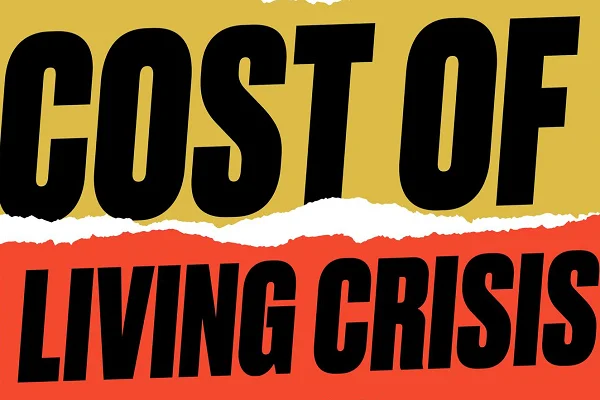Increased Mortgage Interest Rates Combined with the Cost of Living Crisis Forces Buyers and Homeowners to Dip into Savings
It’s no secret that times are hard for millions of UK residents. With the cost of living escalating at a speed not seen since the big recession back in 2008 and the cost of mortgages constantly on the rise, affordability for new buyers is becoming increasingly out of reach, with many not having enough savings for a deposit and others struggling to meet their current monthly mortgage obligations.
Cost of living crisis
Adding to the misery is the fact that inflation rates are at the highest seen for thirty years, pushing monthly outgoings through the roof for the vast majority of the population. Wages are certainly not keeping up with the rapid price increases, resulting in many accessing savings just to meet their monthly commitments. With inflation at a thirty-year high of 9% and expected to reach 10% by next year, households will need to tighten their belts even further.
And it’s not just inflation that is causing chaos for many; the enormous gas and electricity price hike is a worry for almost every household in the country. This is due to the impending increase in the energy price cap coming in October and the embargo on oil and gas from Russia. Diesel and petrol prices are at the highest ever seen, which is having a detrimental effect on drivers and, in turn, causing further increases in prices due to the added costs of manufacturing and logistics.
The Bank of England increased the base rate for the fourth time in a row
Despite increased mortgage interest rates, the property market remains surprisingly buoyant, but experts are predicting a marked slowdown over the next year, when house prices are expected to stabilise and, with any luck, the economy will start to recover, although there is still a lot of uncertainty surrounding this expectation as inflation continues on an upward trajectory.
The main reason for the interest rate hike is that the Bank of England has raised the base rate four consecutive times since December 2021, increasing base rates from 0.1% to 1%. Their reasoning for doing this is to try to tackle the huge increase in inflation. The concept behind this is to discourage people from spending and encourage saving instead.
A third of the income needed for mortgage repayments
Average monthly mortgage repayments are now approximately a third of monthly income. Annual income, on average, in the UK is currently £31,447. So for example, a home bought for the average price of £276,019 on a 25-year loan period with a 75% LTV (£69,000 deposit) and a fixed rate at the current average mortgage rate of 1.84% will equate to monthly repayments of £859.41.
Current figures show homeowners using 32.8% of their monthly wage to meet their repayment obligation, which is up 5% since before the COVID-19 pandemic and close to levels seen during the credit crunch of 2008 when the UK was plunged into a crippling recession.
CEO of Octane Capital, Jonathan Samuels, commented: “The cost of living crisis is a current cause of great concern, and many homeowners are not only combating the inflated cost of day-to-day living but also the monthly cost of their mortgage following a string of interest rate increases.
“At the same time, wage growth has simply failed to keep pace with these rising costs, and so the proportion of our income required to cover our monthly mortgage commitments is now substantially higher than it has been for many years.
“Unfortunately, this cost only looks set to increase, as we expect to see interest rates increase further throughout the year. The best advice for those currently struggling is to consult a mortgage professional and see if they can swap to a product offering a better rate. For those currently looking to buy, it’s vital to factor in any potential increase and not borrow beyond your means based on current rates.
“While the current cost of borrowing may still remain fairly favourable, it’s vital you consider what any further increases may mean for your financial stability, as those borrowing right up to their limits initially are sure to struggle further down the line.”
Savers are forced to access funds to survive
It’s not surprising that a huge number of UK residents have been forced to use savings to get through the month, particularly in the last year. That is true for those lucky enough to have savings to fall back on, but the financial strain on those who have little to no savings is on the rise, with many getting deeper into debt, and the forecast for the next twelve months does not look bright.
According to a report from the Yorkshire Building Society, aptly named “Inflation Nation”, 17% of UK households had no savings at all. The report, which surveyed 4000 households, revealed that 39% had withdrawn funds from their savings account, with a further 17% taking out over £1,000 to meet their financial obligations.
The report went on to reveal that the vast majority of people were either unable to save anything at all or were saving significantly less than they would typically be able to save.
The report went on to show that, of those surveyed, around 40% predicted increases of between £100 and £500 in monthly bills over the next year, making it even harder, if not totally impossible, to increase savings.
Government help for millions
On May 26, Rishi Sunak announced a £15 billion package to help UK households with escalating energy prices. Poorer households will be eligible for a one-off £650 payment to help with gas and electricity bills, with the rest of UK households receiving a £400 discount.
He stated, “We know that other countries in Europe have taken measures to help households with their energy bills, so this is obviously very helpful from an economic perspective, unlike the previous plan that was made available in March.”
“The government’s measures are really quite important because we know that there are a lot of people in this country who don’t have any form of savings.
“If a large proportion of the population starts to reduce their expenditure in other parts of the economy, then I think we could be in a very, very difficult economic situation.”
Although this help is welcome, for many households, it will not be nearly enough to keep them out of an impending financial hole over the next twelve months, with the cost of living crisis not expected to end any time soon.
How Will the Most Recent Hike in Interest Rates to 1% Impact Your Mortgage?
The Bank of England has, for the fourth time in a row, increased interest rates this week. In a bid to tackle the spiralling inflation rate, the bank has raised rates from 0.75% to 1%. With the cost of living crisis seriously affecting household budgets and causing financial stress for millions of UK citizens, it is critical that the Bank of England find a way to stabilise the economy to prevent inflation from rising even more.
The increase means any homeowners on variable-rate mortgages will see their monthly repayments increase, while those on fixed-rate mortgages will be safe until the end of their fixed period.
The Bank is aiming to bring down the inflation rate, which is currently at 7%, back to its target of 2% by increasing interest rates, which will discourage lending and encourage saving, but experts are warning that by doing this, the Bank is pushing people to their financial limits. Some, however, believe that despite the hike, interest rates are still relatively low.
Personal finance analyst at investing platform Best invest, Alice Haine, said, “While mortgage rates will rise, the cost of borrowing is still historically low, so there’s no need to go into full panic mode yet.
“Yes, most lenders will pass the rate rise onto borrowers, but with interest rates still very much on the low side, the increase in percentage terms is modest.”
She went on to say that with living costs being so high, the pressure was increasing: “This might not have been an issue in a normal economic climate, but in the current cost-of-living crisis, every pound matters as households struggle to balance the books.”
Some experts feel that the Bank of England’s actions will be either a grave mistake or incredibly insightful, depending on what happens over the months to come.
James Andrews, senior personal finance editor at money.co.uk, said, “One thing we can say for certain,” he added, “is that it will do almost nothing to bring down the cost of living for households across the UK, which is being driven by global energy prices and supply chain issues.
“Another thing we can say for certain is that it will make borrowing more expensive at a time when more and more people are being forced into debt to meet rising bills.
“We can also say with some certainty that it will put downward pressure on house prices, making mortgages more expensive at a time when rising essential bills make them less affordable too.”
How does the increase affect your mortgage?
There are approximately 1.1 million homeowners on standard variable rates in the UK and 850,000 people with a tracker, and all of them should expect to see their payments increase.
It is typical for lenders to adjust interest rates accordingly when the Bank of England raises rates, although they are under no obligation to do so. Generally, they do tend to pass on the increase.
Tracker deal clients are expected to see an immediate increase in payments.
Sarah Coles, senior personal finance analyst at Hargreaves Lansdown, said: “Banks will be falling over themselves to pass on the rise to variable-rate mortgage customers before the ink dries on the Bank of England announcement.”
As an example, a homeowner with a 25-year standard variable rate mortgage of £300,000 can expect to see a monthly increase of around £40. The advice is to try to remortgage at a fixed interest rate to protect against any further increases.
How does the interest rate increase affect fixed-rate mortgages?
Essentially, those on fixed rates (approximately 75%) will not be affected. However, many of these deals will come to an end this year, so it is advisable to look around before the end of the period, bearing in mind that mortgage offers are valid for 6 months.
Alice said: “Shopping around now for a deal might also be wise for those on a fixed-rate deal with a 2022 expiry date or those looking to remortgage, as mortgage offers are often valid for a number of months. This will protect them from the effects of further hikes and help to avoid a financial shock.”
Are there any pros to the increase in base rate?
The ones benefiting from the increase are the savers! With the increase in rates, interest on savings will also increase, which is great news for those trying to save up a deposit.
The downside here is that with the inflation rate at a forty-year high, the interest on savings is eroded by the cost of living crisis.
Seven out of Ten First Time Buyers Delay Getting on to the Property Ladder as the Cost of Living Continues to Rise
Seventy percent of first-time buyers are holding back on buying their first property as the cost of living continues to rise, according to a report released by the Nationwide Building Society.
The research shows that people who were planning to get their foot onto the property ladder in the next 12 to 24 months have made the decision to hold off, chiefly due to the difficulty of saving up the deposit. With the cost of living spiralling, rocketing fuel prices, energy cap increases, and the war in Ukraine, British household monthly outgoings have increased to the point where many potential buyers have no disposable income and therefore are unable to save.
The expected time that first-time buyers were expected to delay was averaged out at two years, according to the report. Broken down, the figures showed that 57% would delay for two years, while 77% would delay for up to three years. Nearly 20% stated that they would now not buy for over three years in order to be able to raise the funds needed.
The report showed that there were variations in the figures according to region, with 23% in the South West and 28% in Wales saying they would wait more than three years.
The survey involved 2,051 participants, all first-time buyers looking to purchase within the next five years. The biggest hurdle they identified was the inability to raise the deposit.
With the typical deposit at 10%, it’s no wonder that first-time buyers are struggling, as this equates to around 60% of the average gross annual income.
As far as the opinion on the most difficult aspect of homeownership goes, 28% felt it was coming up with the deposit, 14% thought that it was the ability to borrow a sufficient amount for what they wanted to buy, and 12% considered keeping up the monthly payments to be the most concerning issue.
Nine out of ten people surveyed felt that the current cost of living and the predicted further increases in interest rates and energy prices were the main reasons for not being able to raise funds. 50% have reduced the amount they are saving, while a further 38% are using the savings they have to help pay their monthly bills.
One of the questions put to the participants was whether they felt 2022 was a good time to purchase their first property, resulting in an almost equal but split response, with 51% saying no and 49% saying yes.
Another problem that has arisen for first-time buyers is the ever-increasing property prices, which have priced many potential buyers out of the market. Coupled with rising rental costs, 43% of tenants said saving for a deposit was just impossible, according to the report.
69% are considering looking at areas with more competitive housing prices in order to be able to buy a larger property. Willingness to move away from London and its typically high prices was recorded at 79%.
The report showed that most first-time buyers expected to be on the property ladder at around 27 years old, although 30% felt that buying before 30 years old was highly unlikely due to financial pressures.
Due to all of these limitations, many first-time buyers are considering the option of buying with someone else in order to realistically have a chance of making their first home purchase.
Should I Port My Mortgage, and What are the Alternatives?
Taking your mortgage with you when you move is called porting, but is it a good idea, and will your lender let you do this?
The choice to purchase a mortgage does not always lie with the homeowner, and some lenders will not even consider allowing you to do this.
We look at the process of obtaining a mortgage and whether it is the right path for you when you move home.
Porting a mortgage explained
Although not many people know this, there are a great many mortgages that are ‘portable’, in other words, can be transferred from your current property to a new one. However, even though on paper your loan may be portable, you may still be blocked from doing this.
Although this may be an attractive feature of a mortgage, it does not guarantee that you will actually get permission from your lender.
A few reasons why porting may not be advisable include the following:
- You are required to reapply for your mortgage and risk being rejected. When porting, you will need to go through the application process all over again, and there will be no guarantee of acceptance. Your personal circumstances will likely have changed, and this can affect your chances. Alternatively, the lender’s application criteria may have been altered to reflect the current market.
- You may not be able to borrow the amount you wish. If you are planning on moving to a bigger or more expensive property, you may be turned down on the basis of affordability criteria.
- You may need to take out two loans. If you are moving to a more expensive home, you may need a second loan to cover any additional costs. The lender may require you to put any additional funds through a separate mortgage product, which will undeniably result in additional arrangement fees and legal costs.
- You may end up with a high-interest rate. If your lender does allow you to port and approve a larger amount, you may end up agreeing to a higher interest rate as you will be limiting yourself to a single lender and thereby not taking into account competitive interest rates available from other lenders.
What can you do if you can’t port?
The alternative to porting, if your lender does not allow this, is to find a new mortgage. Leaving your current mortgage early can result in charges and fees, so it is best to weigh up all your options before making any commitments.
- Early repayment charge: If you are still in the introductory offer stage of your home loan, you may be subject to charges should you change your mortgage. There are unlikely to be any charges levied should you be past this initial deal period.
- Exit fee: When a mortgage is paid off, you typically need to pay an exit fee. Normally, this is just a few hundred pounds, but you may have paid it at the onset of your mortgage, so make sure you check first.
- Fees for new mortgage: You will be required to pay arrangement fees and legal fees for any new mortgage you take out following your exit from a previous home loan.
Should you port if other deals look better?
It’s all about the calculation in this circumstance. The numbers don’t lie, and it may very well be the case that you can find a much better deal with lower interest rates by shopping around. There may be exit and early repayment fees, so make sure to account for this.
Legal Advice Has Become Mandatory for All Equity Release Customers
This month, the Equity Release Council made it mandatory for all UK citizens looking to release equity to have at least one face-to-face visit with a solicitor before committing to any plan.
This marks a return to pre-pandemic criteria following a temporary change in rules by the Equity Release Council in April 2020. The changes were made so that customers could still access equity release products when lockdowns were the norm and face-to-face meetings were not possible due to social distancing rules.
New equity release customers have been required to take out independent legal advice since the first industry standards were formulated back in 1991, with the legal requirement of a face-to-face meeting added later in 2013.
With many companies across all industries forced to rethink their working environment during the pandemic, a temporary change to the face-to-face requirement was made, with the application process being a mix of telephone calls, documented video, and written advice.
This resulted in an increase in the amount of interaction between the client and the solicitor so that extra checks could establish the customer’s identity and whether they were of sound mind and had the mental capacity to enter into a legal contract, as well as the agreement to proceed by all parties with no coercion or duress.
Cases that were already in progress prior to the recent reversal of requirements must now reach completion by the end of July this year. All new cases as of April 19 will now have the legal requirement for a face-to-face meeting with a legal advisor in order to be accepted for equity finance. Despite the changes only coming this month, the first quarter of 2022 shows that most equity release customers did seek face-to-face legal advice.
Chair of the Equity Release Council, David Burrowes, commented: “The temporary amendment to our requirement for face-to-face legal advice served its purpose well by protecting customers and maintaining their access to vital funds in trying circumstances.
“The Council’s unique ability to bring together firms from across the market helped to identify a practical solution whereby customers were not cut off from money tied up in their homes, which in some cases was key to accessing care services when they most needed them.
“While restrictions have ebbed and flowed during the pandemic, we are hopeful the worst is now behind us. The time is right to return to the default of in-person legal advice while learning lessons about how technology can best support the overall process and customer experience.”
CEO of Equilaw and non-executive director of the Council, Claire Barker, added: “Independent legal advice is one of the unique distinguishing factors that sets equity release apart from other retail financial services when it comes to customer safeguards and protections.
“Legal firms were able to preserve this important link in the chain throughout the pandemic, despite the adverse operating conditions. Industry collaboration on risk management and sharing of best practices meant we could uphold standards of consumer protection and demonstrate this to lenders and funding partners.
“While face-to-face legal advice remains the gold standard, many uses of technology during the pandemic can continue to benefit customers in the long run. A good example of this is financial advisers using video conferencing to bring family members into conversations about releasing equity or solicitors using online case trackers to liaise with clients.”
High Earners at Risk of Becoming Mortgage Prisoners
Many high-earners with large mortgage obligations are finding themselves unable to refinance as lenders tighten lending criteria following the recent tax increases. Many homeowners who bought during the pandemic, when the market was booming, may find themselves trapped and unable to move if they have gone beyond their means to buy the property.
With lenders taking the recent cost of living increases into account when considering refinancing loans, the likelihood of being approved has massively decreased. Lenders are looking at high earners, especially those who are paid by dividends and are considering the increased tax on dividends when looking at affordability.
This month, Santander announced that they will be adjusting their lending criteria to include the recent energy, fuel, inflation, and tax hikes.
Lewis Shaw, of Shaw Financial Services, explained: ‘With lenders now really starting to tighten their belts, we could easily see a scenario where over-leveraged borrowers with big mortgages may struggle to remortgage as lenders’ affordability models are adjusted in line with tax rises and the cost of living crisis.’
He added, ‘Business owners who pay themselves in dividends will be at particular risk, being squeezed from every direction.’
‘Not only do they have to cope with the employer’s National Insurance increase, corporation tax hikes, and higher dividend tax rates, hitting their own disposable income, but they also have to face down calls from staff for wage increases. It’s a brutal balancing act.’
Graham Cox, of the Self Employed Mortgage Hub, said: ‘Many company directors have paid top dollar for large, overpriced properties during the past two years.
‘The Stamp Duty holiday, exceptionally low mortgage rates, housing stock shortages, and the ‘race for space’ have driven up house prices to absurd heights.
‘But, with an additional 1.25 per cent on dividend tax in the 2022–23 tax year, the National Insurance hike, huge cost of living increases, and steadily increasing mortgage rates, lenders’ affordability criteria are already tightening.
‘When the time comes to remortgage, it’s possible overstretched business owners could be left stranded on unaffordable standard variable rates. It depends on whether their existing lender is willing to provide a new deal.
‘Nonetheless, if house prices go into sharp reverse, which is a distinct possibility, we’re looking at negative equity, repossessions, and a whole world of pain.’
Santander stated that the new increase in national insurance, increased household outgoings, and dividend tax will be factored into the affordability test.
Graham Sellar, of Santander, said: ‘We adjust our mortgage affordability calculation on an annual basis, using updated household spending data from the ONS and taking account of other factors, including the Bank of England base rate alongside national insurance and tax threshold changes.
‘We have adjusted affordability on this basis every year for the last ten years.’
This comes following the Chancellor of the Exchequer’s announcement of a 1.25% increase in dividend tax and national insurance contributions (from 12% to 13.25%). Tax on dividends has increased by 1.25%, so for basic, higher, and additional tax earners, it becomes 8.75%, 33.75%, and 39.35%, respectively.
Adding to the misery, energy price caps have risen from £693 to £1971 at the start of the month.
Imran Hussain, of Harmony Financial Services, said: ‘With living costs spiralling out of control and NI and dividend income tax rates rising, it should not come as a surprise that lenders will have to adjust how much they will allow people to borrow.
‘They have a responsibility to ensure all borrowing is affordable. Some have done so already, while others are doing so.’
Reducing Borrowing Costs with New Equity Release Rule
Homeowners, who have taken advantage of equity release finance, are now able to make additional partial payments without any charges or penalties in a bid to reduce borrowing costs.
Although this is a feature already offered with some later-life lending products, as of March 28th, the Equity Release Council announced that it will be mandatory for lenders to include this feature with all equity release finance products.
The ability to make extra payments will result in homeowners reducing the impact of compound interest later down the line and decreasing the overall cost of equity release.
Equity Release Finance is a way of releasing the tied-up cash in your home. It allows for borrowing against the equity in your house without being required to make any repayments. The loan is repaid when the borrower either moves into residential care or passes away. To be eligible for equity release, you must be over 55 years old.
This new rule will allow the homeowner to make payments as and when they wish, thereby reducing the amount that the lender will be repaid when the time comes.
The Equity Release Council, which announced the news regarding the new product safeguard on Monday, stated that over the next decade, a total of £39 million in combined savings can be achieved, with further figures predicted to be a whopping £99 million in expected savings over the next twenty years.
Data shows that, in 2021, more than 125K part payments towards equity release plans were made without penalty.
Jim Boyd, CEO of the Equity Release Council, said: “The right to remain in your home for life, with no requirement to make ongoing repayments and no threat of repossession, has been central to the appeal of equity release since 1991 and remains a core pillar of the modern market.
“Our new product standard adds to this by ensuring people have the freedom to reduce their borrowing if circumstances change.
“It enables equity release customers to mitigate the effects of compound interest and reduce their borrowing costs in later life, which we know is often one of their main concerns.”
This latest product standard, released and enforced by the Equity Release Council, sets out the following parameters:
It gives the homeowner the right to live on the property for the rest of their lives; they will also have no obligation to make any payments until they go into full-time care or pass away.
The interest rate is capped or fixed for life. The rate of interest will never change, even when base rates change.
No negative equity guarantee: The debt will never be more than the home is valued at, meaning that relatives will not be burdened with any funds owed to the lender.
The right to move the loan: Providing it meets the criteria, the loan can be moved to a different property.
Jim Boyd added: “Equity release today is a flexible financial planning tool for a range of scenarios, from gifting to family to supporting better living standards over longer lives in retirement.
“Consumers should always use a Council member to explore their options and alternatives to equity release, to benefit from product protections and expert advice, and to decide if it is right for them.”
Price of Mortgages Predicted to Be £800 More Per Annum Than in October 2021
According to mortgage advisor L&C, people looking to remortgage their homes are expected to pay, on average, an additional £800 each year when compared to just five months ago.
The analysis was based on several parameters, using the example of a homeowner who had 40% equity in their property and was looking to take on a 2-year fixed-rate mortgage over a 25-year period on a mortgage of £150,000.
Figures provided by the Bank of England showed that applications for remortgage products rose in the last quarter of 2021 in proportion to overall lending. Market experts indicated that homeowners remortgaging the properties were hoping to grab a good deal before interest rates rose further, as they are predicted to do in the coming months.
Interest rates from major lenders were used by L&C, which were averaged out to create the analytic report.
The data showed that in October 2021, with interest rates at an all-time low, borrowers would be paying a little more than £557 per month on a 2-year fixed-rate mortgage deal.
If the same homeowner were to remortgage now, they could expect to pay around £627 per month, which will equate to an extra £70 monthly, which is approximately an additional £840 per year.
In some instances, good mortgage deals are only made available to borrowers for a very short period of time, often just days, and are then removed from the market. What homeowners need to realise is that they can apply for a new mortgage up to six months prior to the end of their current mortgage arrangement.
L&C also stressed that offers from lenders are typically valid for 3 to 6 months, giving the borrowers “Rates are moving quickly, though, and deals rapidly come and go, often only lasting a matter of days before being replaced with higher rates. Sufficient time to make an application despite the fact that an ERC (early replacement charge) may stay in place for several months.
Associate director at L&C Mortgages, David Hollingworth, commented: “Mortgage rates have been shifting rapidly as lenders are forced to adapt to the impact of market expectations of higher rates on their funding costs.
“The sheer pace of change is something that could take borrowers by surprise, especially when the cost of living and other outgoings such as energy are already rising too.
“Fixed rates are still at historically attractive levels, so borrowers should review their current deal to make sure that they are on the best deal and protecting their position, especially against a backdrop of rocketing outgoings and further potential increases in the base rate.
“Borrowers can lock in at a current rate up to six months ahead, giving them the chance to review well ahead and ensure a smooth switchover when their current deal ends. That could help them get ahead of any further rate rises.”







